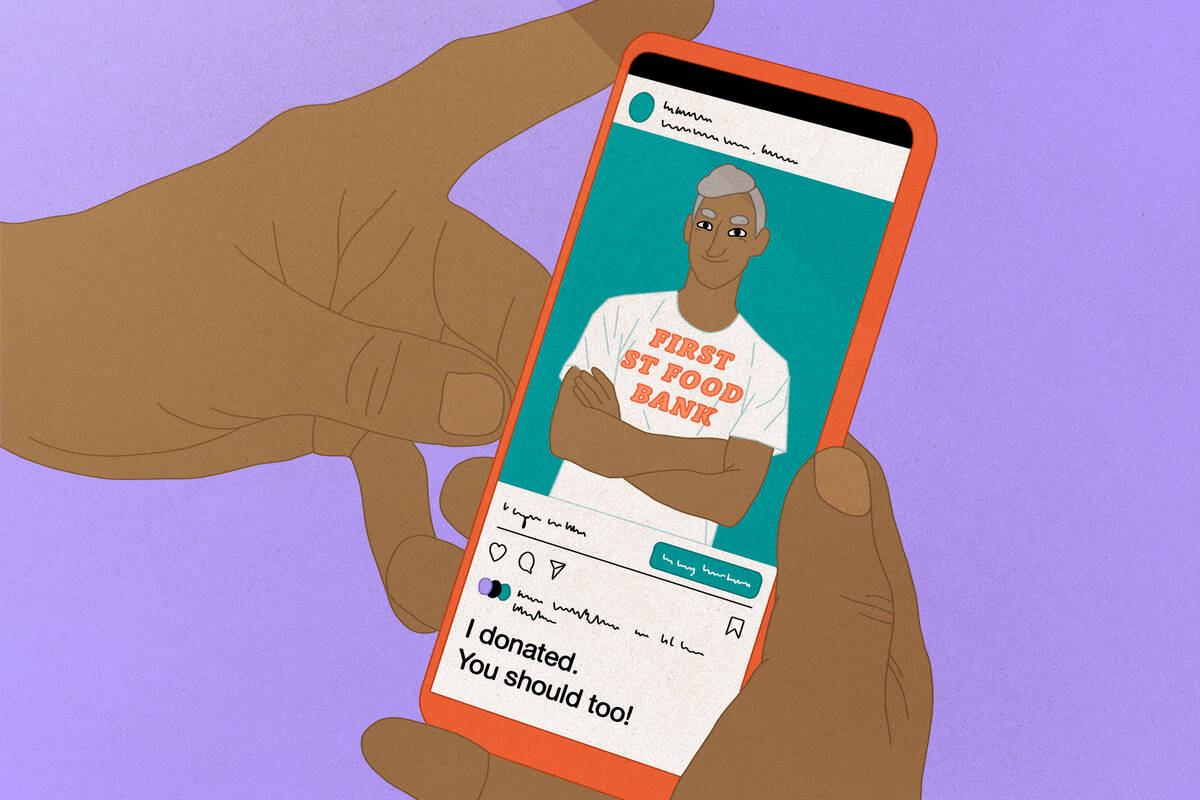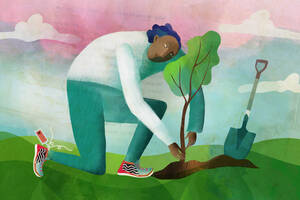Marketing Social Impact Jun 1, 2023
Yes, You Should Hit “Share” when You Make a Charitable Donation
Nobody wants to come across as bragging, but when donors stay mum, charities miss out. New research offers a strategy to embolden givers.

Lisa Röper
Most charities would be thrilled for donors to spread the word about their donations on social media. After all, word-of-mouth marketing is a powerful, low-cost tool for charities and can also reinforce norms of generosity.
But there’s a rub. For individual donors, the benefits of sharing are much dicier. There’s a risk that the sharer’s followers will think of them as a braggart or as someone who conducts selfless acts for personal gain.
Kellogg School assistant marketing professor Ike Silver wondered if there was a way around this conundrum.
In new research, Silver and his fellow researcher Deborah Small of Yale University found that when donors saw a message that asked them to share their donation to their social media accounts to promote the cause (rather than simply just sharing about their donation), it increased clicks on the links to share, it led to a higher likelihood of recruiting at least one more donation to the charity, and it raised more money.
“The way we give or withhold moral credit by saying that someone is a good person or that someone is actually bragging doesn’t necessarily incentivize behavior that is good for the world from an outcomes perspective,” Silver says. “But this is the first experiment to show a direct impact of a marketing message on downstream funds raised via word of mouth. It is a proof of concept that these kinds of interventions are possible.”
Donations rank as most uncomfortable topic to discuss
Social media has removed many of the barriers between what’s considered public and private, but donations are still thought of as private matters. In many cultures, anonymous donations are considered especially commendable.
To find out just how strange people feel discussing their own charitable giving, Silver and Small conducted a survey of 198 participants, asking them to report how comfortable they would feel talking about 21 different expenditures with friends and family. These expenditures ranged from the mundane (buying a dozen eggs) to the cultural (tickets to an art exhibit) to the financial (investing in the stock market).
Participants ranked charitable donations as the most uncomfortable topic to talk about.
“People who broadcast their generosity via charity are typically thought of as virtue signalers and are judged negatively,” Silver says. “It’s this thing that should reflect positively on the person, but people were still more uncomfortable talking about it than anything else.”
Most people think about reputation first
The downside of this is that norms around giving to charity are often opaque, undermining both donations to charities and altruism altogether. Research has shown, for example, that altruism itself can be contagious, inspiring others to also take part in acts of kindness. But if altruistic acts are considered taboo discussion topics, this sort of ripple effect cannot take hold.
To explore donors’ thought process when asked to share about their donations, the research team recruited 377 participants and asked them to write down the name of a charity or cause they personally supported. The participants then imagined making a donation and receiving a follow-up message from the charity nudging them to share about their donation on social media.
“It’s this thing that should reflect positively on the person, but people were still more uncomfortable talking about it than anything else.”
—
Ike Silver
Next participants received one of three writing prompts. One group wrote about the consequences that sharing would have on their own reputation. Another group wrote about the consequences sharing would have for the charity. And a third wrote whatever came to their mind when considering whether to share on social media. They all then indicated their willingness to share.
Those who considered the consequences for the charity (rather than for their own reputation) indicated a higher willingness to share than the other two groups.
When researchers analyzed what participants had actually written, they noticed a telling pattern: those who wrote about how sharing would impact the cause nearly always mentioned positive outcomes, while those wrote about the impact on their reputation were substantially more negative.
Meanwhile, the majority of those who could write about whatever came to mind mentioned the impact it would have on their reputation, rather than the impact it would have on the cause.
“It showed us that most people are really thinking about their reputation, but that you can change their baseline to consider the cause,” Silver says.
Reframing the messaging around sharing
But could there be a much simpler way to change this baseline?
To find out, the team then partnered with DonorsChoose.org, a platform where users can donate to classroom-based fundraisers in underfunded schools in the United States. When donors give through the site, they encounter a pop-up window that thanks them for their donation and asks them to share their donation on social media.
The research team wondered whether this pop-up could be used to reframe donors’ thinking. If they tweaked the message to make donors think about helping the cause rather than hurting their own reputation, would donors be more likely to share? And would the schools see more money?
During a four-week period in late summer 2020, donors who gave through the site (more than 77,000 overall) were randomly assigned to see one of two pop-up windows. Half of the donors saw the website’s standard messaging: “Share this classroom with family and friends.”
The other half saw a new message: “Your donation can start a chain reaction, but only if you tell others about the cause. Share this classroom with family and friends.”
Both versions of the pop-up window contained icons that linked to social-media platforms. If donors clicked on these icons, they were directed to the social-media platform and supplied with a unique referral link, allowing the research team to record downstream referrals.
Because users shared to their private social-media accounts, the research team could not see any specific messaging the donors wrote when they shared the link. But the link was personalized, so they could discern that any donation that came through the link was a direct result of the sharer’s social post.
Increasing both sharing and donations
So did the new pop-up-window messaging work? The research team found that donors who saw the new messaging were 5 percent more likely to click on a social-media icon.
Though they could not directly measure the number of donors who shared on social media, they could measure the downstream effects. Those same participants were also more likely to recruit at least one more donation from another donor; they also recruited an average of $0.22 more in subsequent donations (16 percent higher than the donations recruited with the standard message).
“It was a modest effect, but we were able to do it with a light touch,” Silver said. “We didn’t give donors a bunch of new information. We just changed the messaging, and it had a statistically and economically significant impact.”
Notably, donors who gave more money were actually less responsive to pop-ups asking them to share. But controlling for those low click-through rates, the more a donor gave, the more likely they were to recruit at least one downstream donation. The team attributes this result to potentially older, more well-off, less tech-savvy donors who are less likely to click through to share on social media, but when they do, engage a more affluent network.
The team also tracked the donors for the next few months to ensure that donors weren’t turned off by the messaging that asked them to share. Fortunately, that was not the case: there were no negative effects on their likelihood of returning to give again.
Reducing the focus on bragging to promote altruism
The implications for charities are clear: ask donors to share for the cause.
This makes donors less likely to consider the reputational risks of sharing. In fact, it may be worth considering additional ways of achieving this goal. For example, the extremely successful Ice Bucket Challenge to raise money for ALS research introduced embarrassment or self-effacement into the sharing campaign.
“When a post is inherently embarrassing, it can make people feel more comfortable that they won’t be thought of as bragging,” Silver says.
As for the implications for individuals, consider speaking out about your favorite causes. Silver certainly is.
“As I’ve studied this more and more, I feel more willing to go out on a limb for causes I care about,” he says. “I’ve felt the apprehension about it myself, but my own research suggest that these causes lose out when we aren’t out there being advocates.”
Emily Ayshford is a freelance writer in Chicago.
Silver, Ike, and Deborah Small. Forthcoming. “Put Your Mouth Where Your Money Is: A Field Experiment
Nudging Consumers to Publicize Donations to Charity.” Marketing Science.



